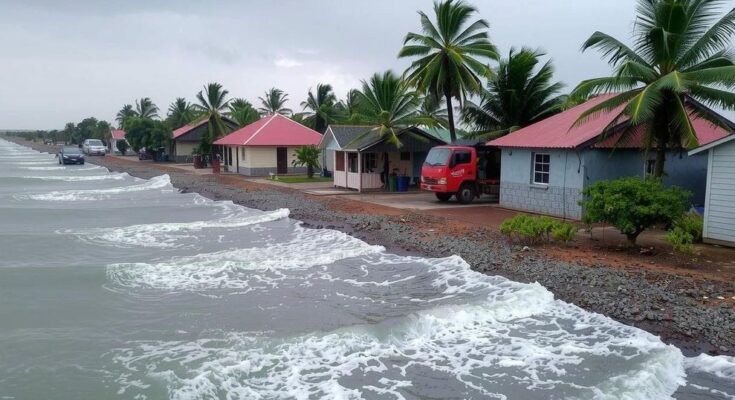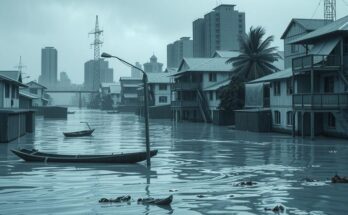Mozambique is on alert as Tropical Cyclone Dikeledi intensifies, affecting Nampula and approaching the Mozambique Channel. Forecasts predict heavy rainfall and strong winds impacting coastal areas, with approximately 255,310 individuals at risk, prompting emergency protocols. Humanitarian readiness is crucial as resources are stretched due to recent cyclone activity.
Mozambique is currently grappling with the implications of Tropical Cyclone Dikeledi, which has re-emerged as a serious weather threat after initially weakening. This cyclone is traversing the Nampula province and is projected to weaken further as it interacts with land. Nonetheless, forecasts suggest that by January 14, 2025, it may re-enter the Mozambique Channel near Angoche, where it has the potential to intensify once again. The National Meteorology Institute (INAM) predicts severe weather across coastal districts, including Mossuril and Angoche, with rainfall amounts reaching up to 200 mm in 24 hours and winds peaking at 120 km/h.
The National Institute for Disaster Management (INGD) estimates that approximately 255,310 individuals may be adversely affected by Cyclone Dikeledi, with 98,000 residing in high-risk zones. In light of this forecast, the INGD has activated emergency protocols in Angoche and Mongicual districts, signifying that preparations are underway. Efforts include disseminating safety advisories to vulnerable communities, facilitating preventive evacuations, and deploying officials to ensure local coordination in response to potential disasters. Meanwhile, humanitarian organizations stand ready to provide assistance; however, their resources are notably strained as Dikeledi marks the second cyclone to impact Mozambique within a month.
As the cyclone advances, the provinces of Nampula, Cabo Delgado, and Zambezia are encountering extreme weather conditions, especially near regions anticipated to be affected by landfall. The significant rainfall and strong winds pose risks of flooding in river basins and may cause substantial damage to infrastructure, including roads, schools, and health facilities. Notably, at least 491 educational institutions and 62 health facilities are under threat from the cyclone’s destructive potential.
In summary, the introduction of Cyclone Dikeledi heralds another crisis for Mozambique, with thousands of individuals living in jeopardy. Emergency responses are being mobilized, and close monitoring of the situation continues as the cyclone approaches the Mozambique Channel, where its behavior may change dramatically due to ocean conditions.
The recent development of Tropical Cyclone Dikeledi in Mozambique comes amid an ongoing pattern of severe weather events in the region. Dikeledi re-intensified after an initial weakening and poses significant risks to several provinces, predominantly Nampula, which is already grappling with severe weather repercussions. While emergency responses are being activated by local authorities, the potential re-intensification of the cyclone could further exacerbate the situation and lead to devastating impacts on infrastructure and civilian safety. The frequency of cyclones within a short period highlights the vulnerability of Mozambique to climate-induced weather events, necessitating heightened vigilance and rapid response action.
In conclusion, Mozambique is confronting the imminent threat of Tropical Cyclone Dikeledi, with severe weather conditions affecting vulnerable provinces. As preparations are implemented to mitigate the potential consequences, authorities are emphasizing the urgency of community safety and infrastructure readiness. The expected rainfall and winds present substantial risks, particularly to human life and essential services, highlighting the need for continued monitoring and proactive disaster management efforts as the situation develops.
Original Source: reliefweb.int




